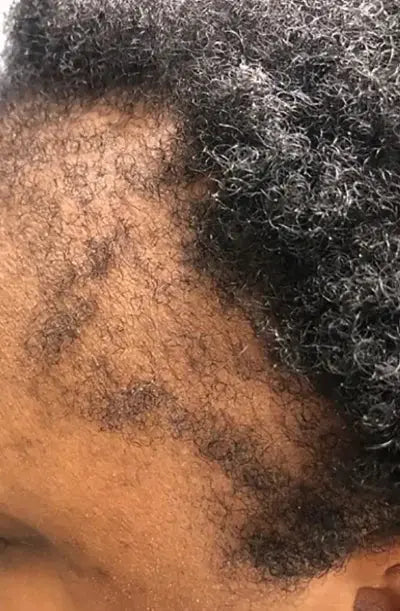
Is Your Frontal Causing Hair Loss? The Ultimate Guide to Protecting Your Edges
Share
Is Your Frontal Causing Hair Loss? The Ultimate Guide to Protecting Your Edges
Posted by SB Boutique | Hair Education Series
Frontals are a game-changer. They offer a flawless, ear-to-ear hairline that gives you a truly versatile look. Whether you're rocking a high ponytail, a sleek bun, or a simple part, the seamless finish of a frontal can make you feel incredible. But for many, this amazing style comes with a hidden fear: frontal causing hair loss.
This isn't a topic many hair companies want to talk about, but it's a very real concern. The constant tension and use of adhesives around the hairline can lead to a condition called traction alopecia, which can cause thinning edges and, in severe cases, permanent hair loss. You are not alone in this struggle, and this guide is here to provide the honest and actionable advice you've been looking for. We will explore the signs of damage, the science behind it, and most importantly, how you can protect your hairline without sacrificing your style. This isn’t about scaring you, but about empowering you to make the best decisions for your hair’s long-term health. We've got a solution for you, even if you’re concerned about a frontal causing hair loss.
The Problem: The Hidden Truth About Frontals
Let’s be honest—nothing beats the look of a perfectly installed frontal. It provides the illusion of natural hair growing directly from your scalp, allowing for endless styling possibilities. You can switch your part, pull your hair back without a tell-tale track, and feel like you're wearing your own hair.
However, this flawless look comes at a cost for many. Frontals are typically secured around the entire perimeter of your hairline using a combination of glue, tape, or an elastic band. This constant, daily tension on the delicate hairs along your edges is the primary cause of damage. Each time you apply and remove the adhesive, or even just wear the frontal for an extended period, you're putting stress on the hair follicles. Over time, this repeated stress can weaken the follicles, leading to inflammation and, eventually, hair loss. A worn-out, ill-fitting frontal causing hair loss is not a myth—it is a reality for many. The issue isn't always the frontal itself, but the installation and maintenance. Improper application, a poor-quality stylist, or simply leaving a frontal on for too long can all contribute to this very real problem of frontal causing hair loss.
The Warning Signs of Frontal Causing Hair Loss
Before the damage becomes irreversible, your hairline will send you clear signals that it's in distress. Learning to recognize these signs is the first step in preventing permanent hair loss from your frontal. Don't wait until the damage is done.
Here are the key warning signs that a frontal causing hair loss is a potential issue for you:
-
Redness or Irritation: If the skin around your hairline is red, itchy, or tender after installation or removal, it's a sign of inflammation. The glue or tape may be causing an allergic reaction, or the tension is too tight.
-
Thinning Hair: This is the most obvious sign. You might notice your edges becoming visibly thinner or a receding hairline where your frontal is attached. This thinning is often accompanied by tiny, broken hairs that appear brittle and fragile.
-
Tiny Bumps or Pimples: Small pimples or bumps along the hairline can be a sign of infected or inflamed hair follicles, a direct result of product buildup and constant tension. This is a common symptom of a frontal causing hair loss.
-
Pain or Discomfort: A constant feeling of tightness, pulling, or pain at the hairline is a major red flag. Your frontal should not be causing you pain.
If you are experiencing any of these signs, it's time to take a break from your frontal and give your edges the rest they desperately need. This is a crucial step in preventing permanent frontal causing hair loss.
The Solution: A Healthy Alternative to Frontals
So, what is the solution if you want to protect your hairline but still love the look of extensions? For many, the answer lies in switching to a closure.
What is a Closure?
A closure is a smaller hairpiece, typically 4x4 or 5x5 inches, designed to be sewn in at the crown of your head to close off your sew-in. It covers the horseshoe-shaped area at the top of your head, giving you a natural-looking part while leaving your own hairline untouched.
How Closures Prevent Hairline Damage
Switching to a closure is a highly effective way to prevent frontal causing hair loss for several key reasons:
-
No Direct Tension on Your Edges: Because a closure is installed behind your natural hairline, there is no direct tension on your delicate baby hairs. This eliminates the primary cause of traction alopecia.
-
Glue or Adhesive is Optional: Closures can be sewn into the braided foundation of your hair, so there is no need for damaging adhesives that can cause irritation and breakage if you do not want to use it.
-
Less Maintenance: Closures don’t require daily touch-ups with glue or styling products on your hairline. This reduces the amount of manipulation and product buildup, allowing your edges to breathe and grow freely.
-
Still Flawless and Versatile: A well-installed closure with high-quality raw hair can be just as seamless as a frontal. You can still achieve a natural-looking part and style your hair in various ways without the constant worry of damage, and without a frontal causing hair loss.
A New Chapter: Embracing a Closure for a Healthier Hairline
If you're ready to say goodbye to the anxiety of a thinning hairline, transitioning to a closure can be a truly liberating experience. It’s an investment in the long-term health of your natural hair without compromising your style. Here's how you can make the switch:
-
Choose the Right Closure: Closures come in different sizes and parting options. A free-part closure offers the most styling versatility, allowing you to create a middle or side part as you wish.
-
Invest in Quality Raw Hair: The quality of your closure is just as important as the installation. A closure made from 100% raw hair, like ours, will have a naturally full and realistic density, making it blend seamlessly with your bundles. Because the cuticles are intact, it will also hold its style better and last longer, further preventing a frontal causing hair loss by minimizing the need for constant replacement.
-
Find a Skilled Stylist: A proper installation is key. Ensure your stylist knows how to install a closure securely without pulling too tight on your braids or adding unnecessary tension. They should also be able to create a flawless part that looks completely natural.
Ultimately, your hair extensions should be a protective style that enhances your look without harming your natural hair. By understanding the risks of frontal causing hair loss and exploring safer alternatives like closures, you're taking control of your hair health and making a smart, long-term decision. You deserve a style that makes you feel confident, beautiful, and completely secure in your hair's future. This guide provides an honest perspective on a common problem, proving that you don't have to choose between a great style and a healthy hairline. By choosing a closure with high-quality raw hair, you can have both and never worry about a frontal causing hair loss again.
